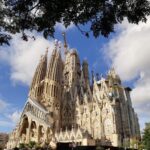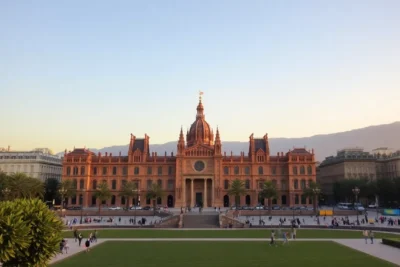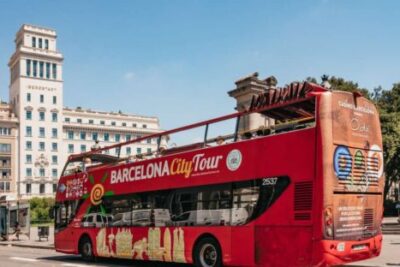
The Sagrada Familia, a masterpiece of architectural innovation and artistry, has captivated the world since its inception in 1882. Designed by the brilliant Antoni Gaudí, this basilica combines Gothic and Art Nouveau styles, making it a unique symbol of Barcelona's cultural heritage.
As we explore The Fascinating History of Sagrada Familia: From Conception to Iconic Landmark, we uncover the vision, dedication, and challenges faced throughout its construction. This extraordinary building not only represents Gaudí's artistic genius but also embodies the spirit and resilience of the city itself.
The Architectural Vision Behind Sagrada Familia's Design
Antoni Gaudí’s vision for the Sagrada Familia was rooted in a profound understanding of nature and spirituality. He believed that architecture should reflect the natural world, which is evident in the basilica's organic shapes and elaborate facades. Gaudí's strategy included the use of geometric forms, inspired by natural elements, allowing the structure to harmonize with its surroundings while also conveying a sense of divine presence.
One of the most striking features of Sagrada Familia is its colorful stained glass windows. These windows are not merely decorative; they play a crucial role in Gaudí’s architectural vision. By employing various hues, he created an immersive experience for visitors, inviting light to dance within the space and evoke different moods throughout the day. This approach emphasizes the importance of light as a spiritual symbol, enhancing the overall atmosphere of the basilica.
- Natural Forms: Use of shapes that mimic nature.
- Geometric Structures: Innovative use of geometry to create stability.
- Symbolic Elements: Incorporation of Christian symbolism in every detail.
In terms of construction techniques, Gaudí pioneered the use of catenary arches and hyperboloid structures, which distribute weight more efficiently and allow for taller, more intricate designs. His commitment to innovation is reflected in the way the Sagrada Familia is built; every stone is carefully chosen and placed to contribute to the overall harmony of the structure. This attention to detail ensures that the basilica remains a living testament to Gaudí’s architectural genius and vision.
The Influence of Antoni Gaudí on Sagrada Familia's Construction
Antoni Gaudí's influence on the construction of the Sagrada Familia is profound and multi-faceted. His architectural philosophy was deeply intertwined with his passion for nature, which he believed should be reflected in every aspect of design. Gaudí approached the basilica not merely as a building but as a living organism, where each element is intentionally crafted to enhance the overall aesthetic and spiritual experience.
One of the key aspects of Gaudí's influence is his innovative use of natural forms. He often drew inspiration from the organic shapes found in nature, which is evident in the basilica's intricate facades and towers. This design approach not only creates a sense of harmony with the environment but also symbolizes the connection between the divine and the natural world. His use of colorful mosaics and textures further adds depth to the structure, inviting exploration and contemplation.
- Structural Innovations: Gaudí implemented catenary arches and hyperboloids, allowing for unparalleled height and stability.
- Symbolism: Every detail, from the façade to the interiors, is infused with Christian symbolism, enhancing the spiritual narrative.
- Light as a Concept: The strategic placement of stained glass windows allows light to play a crucial role in the overall atmosphere of the basilica.
Moreover, Gaudí's commitment to craftsmanship is evident in the meticulous way he directed the construction process. He emphasized the importance of skilled artisanship, ensuring that each stone was not only functional but also meaningful in the context of the grand design. This dedication to detail and artistry ensures that the Sagrada Familia remains not just a building, but a revered iconic landmark of Barcelona, embodying Gaudí's visionary spirit for generations to come.
Milestones in the Construction of Sagrada Familia: A Timeline
The construction of the Sagrada Familia is marked by several significant milestones that chronicle its transformation from a mere concept into a globally recognized architectural marvel. The project began in 1882 under the direction of Francisco de Paula del Villar, but it was soon taken over by Antoni Gaudí in 1883, who dramatically redefined its vision and approach.
Among the pivotal moments in its timeline include:
- 1882: The groundbreaking ceremony takes place.
- 1883: Gaudí becomes the chief architect, introducing his unique designs.
- 1914: The completion of the Nativity Façade, showcasing Gaudí's intricate craftsmanship.
- 1936: The construction halts due to the Spanish Civil War, leading to the loss of many of Gaudí’s original plans.
- 2026: Projected completion date, coinciding with the 100th anniversary of Gaudí's death.
Each of these milestones reflects not only the evolution of the architectural plans but also the perseverance of a vision that has spanned over a century. Despite challenges, including political turmoil and funding issues, the Sagrada Familia continues to attract artisans and architects dedicated to realizing Gaudí's dream of this iconic landmark in Barcelona.
As construction progresses, modern technology and techniques are being employed to help complete the basilica, ensuring that Gaudí's architectural style is preserved while adapting to contemporary building methods. This blend of tradition and innovation stands as a testament to the enduring legacy of the Sagrada Familia.
The Symbolism of Sagrada Familia: What Each Element Represents
The Sagrada Familia is not only an architectural wonder but also a profound embodiment of symbolism that Gaudí meticulously crafted into every detail. Each element of the basilica serves a purpose beyond the aesthetic, reflecting deep spiritual meanings. For instance, the three grand façades—Nativity, Passion, and Glory—represent different aspects of the life of Jesus Christ, inviting visitors to witness a journey through faith.
Within the structure, one can find elements that symbolize the connection between nature and spirituality. The columns, resembling tree trunks, support the basilica while creating an illusion of a forest. This design not only enhances structural integrity but also represents the strength and beauty of creation. Additionally, the intricate sculptures and decorations are infused with Christian iconography, each telling a story that draws visitors into a narrative of divine love and sacrifice.
- Nature as Inspiration: Many designs mimic natural forms, signifying harmony with the environment.
- Light's Spiritual Role: The stained glass windows are designed to cast colorful light, representing divine presence.
- Christian Symbolism: Each façade and detail conveys spiritual teachings, enriching the visitor's experience.
The use of color is also significant; Gaudí believed that light and color could evoke emotions and enhance the spiritual experience. As sunlight filters through the vibrant stained glass, it creates a dynamic play of colors that changes throughout the day, symbolizing the ever-present divine light in our lives. Thus, the Sagrada Familia stands not only as a masterpiece of architecture but also as a living testament to the spiritual and natural worlds intertwined.
Challenges Faced During the Building of Sagrada Familia
The construction of the Sagrada Familia has faced numerous challenges since its inception, primarily due to the ambitious architectural vision of Antoni Gaudí. Initially, the project suffered from a lack of funding, which hindered progress and caused several delays. Financial constraints meant that construction could only proceed as donations were received, resulting in an inconsistent building timeline that spanned generations.
Moreover, the political turmoil in Spain had a significant impact on the construction of the basilica. The outbreak of the Spanish Civil War in 1936 led to the devastating loss of many of Gaudí's original plans and models. This loss not only set back construction efforts but also forced later architects to interpret Gaudí's vision from limited and often fragmented sources, complicating the building process and introducing the risk of deviating from his original intent.
Another challenge has been adapting to modern construction techniques while preserving the integrity of Gaudí's design. As new technologies have emerged, the project has had to balance innovation with tradition. While modern tools have enabled more precise work, they also pose the risk of altering the character of the basilica, making it essential for architects and builders to maintain fidelity to Gaudí’s unique style and philosophy.
Lastly, the sheer scale and complexity of the Sagrada Familia have introduced ongoing engineering challenges. The intricate designs and ambitious heights necessitate advanced structural solutions to ensure stability and safety. This has required collaboration across disciplines, with architects, engineers, and artisans working together to overcome these obstacles while striving to realize Gaudí's extraordinary vision for this iconic landmark.
Sagrada Familia: Its Role in Modern Barcelona and Beyond
The Sagrada Familia is not just an architectural marvel; it is a vital part of modern Barcelona's identity and cultural landscape. As an iconic landmark, it attracts millions of visitors each year, contributing significantly to the local economy. The basilica serves as a focal point for both tourists and residents, fostering a sense of pride and connection to the city’s rich history. Its towering spires and intricate designs symbolize Barcelona’s innovative spirit and artistic heritage, making it a beloved emblem of the city.
Moreover, the Sagrada Familia plays a crucial role in contemporary discussions about urban development and architectural preservation. As Barcelona strives to balance tourism with local life, the basilica stands as a testament to the importance of integrating historic preservation with modern needs. Key aspects of its role in the city include:
- Tourism Boost: Significant economic impact through visitor spending.
- Cultural Preservation: A constant reminder of Barcelona’s artistic legacy.
- Community Engagement: A platform for local events and spiritual gatherings.
Beyond its immediate urban context, the Sagrada Familia has also inspired architects and artists worldwide. Its unique blend of Gothic and Art Nouveau styles has prompted a reevaluation of architectural boundaries, influencing various movements and projects globally. The basilica serves as a beacon of creativity, encouraging architects to explore organic forms and sustainable practices, thus extending Gaudí's vision far beyond the confines of Barcelona.
As construction continues, the Sagrada Familia is set to evolve further, reflecting both its historical roots and modern advancements. The integration of cutting-edge technology in the ongoing construction process ensures that Gaudí's original vision is honored while adapting to contemporary architectural practices. This blend not only preserves the basilica's iconic status but also positions it as a progressive symbol of innovation and cultural dialogue in a rapidly changing world.
 Why Sagrada Familia Was Built: Unveiling the Secrets Behind Gaudí's Masterpiece
Why Sagrada Familia Was Built: Unveiling the Secrets Behind Gaudí's Masterpiece Exploring the Magnificent Sagrada Familia: Opening Hours and Must-See Highlights in Barcelona
Exploring the Magnificent Sagrada Familia: Opening Hours and Must-See Highlights in BarcelonaIf you want to know other articles similar to The Fascinating History of Sagrada Familia: From Conception to Iconic Landmark you can visit the category Blog.
Leave a Reply










Read more!